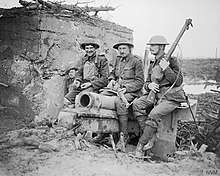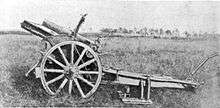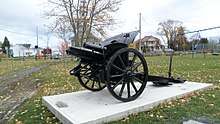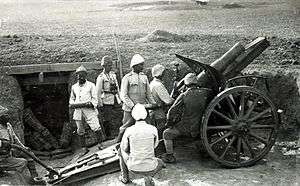10.5 cm Feldhaubitze 98/09
| 10.5 cm Feldhaubitze 98/09 | |
|---|---|
|
| |
| Type | Howitzer |
| Place of origin | German Empire |
| Service history | |
| Used by |
German Empire Ottoman Empire Romania |
| Wars | World War I |
| Production history | |
| Designer | Krupp |
| Designed | 1902-04 |
| Manufacturer | Krupp |
| Produced | 1909-1918? |
| Specifications | |
| Weight | 1,145 kg (2,519 lbs) |
| Barrel length | 1.625 m (5 ft 4 in) L/15.5 |
| Width | 1.53 m (5 ft 0 in) |
|
| |
| Shell | Separate loading cased charge and projectile |
| Caliber | 105 mm (4.13 in) |
| Breech | Horizontal sliding-block |
| Recoil | Hydro-spring |
| Carriage | Box trail |
| Elevation | -13° to +40° |
| Traverse | 4° |
| Muzzle velocity | 302 m/s (990 ft/s) |
| Maximum firing range | 6,300 m (6,890 yds) |



The 10.5 cm Feldhaubitze 98/09 (10.5 cm FH 98/09), a short barreled (1625 mm) 105mm howitzer, also referred to as the 10.5 cm leichte Feldhaubitze (light field howitzer) 98/09, was used by the German Empire as well as the Ottoman Empire in World War I and after. It had a maximum range of 6,300 metres (20,700 ft).[1] German 10.5-cm. light field howitzer (l. F. H. 98/09), with ammunition
History

It was originally built by Rheinmetall as the 10.5 cm Feldhaubitze 98, an old-fashioned, fixed-recoil weapon delivered to the German army in 1898; between 1902 and 1904, it was redesigned, by Krupp, with a new recoil mechanism and a new carriage.[2] However, it wasn't accepted for service until 1909, hence the ending designation 98/09. Existing weapons were rebuilt to the new standard. As usual, two seats were attached to the gun shield. There were 1,260 in service at the beginning of World War I.[3]
Ammunition
The 10.5 cm used three different types of ammunition and the aiming instruments were marked with three different meter scales and a dial sight for both direct and indirect fire. Originally, it used 7 charges of propellant, but this was increased during the war to 8 in an effort to extend its range.[4]
- Feldhaubitz granate 98: A 15.8 kilogram (35 lb) high-explosive shell.
- Feldhaubitz schrapnel 98: A 12.8 kilogram (28 lb) shrapnel shell.
See also
Weapons of comparable role, performance and era
- QF 4.5-inch howitzer British equivalent
References
- Jäger, Herbert. German Artillery of World War One. Ramsbury, Marlborough, Wiltshire: Crowood Press, 2001 ISBN 1-86126-403-8
Notes
- ↑ 10.5 cm LIGHT FIELD HOWITZER MODEL 98/09- Retrieved 2012-02-29. Archived 2012-03-06.
- ↑ Transformation of the 10.5 cm Feldhaubitze 98/09- Retrieved 2012-02-29. Archived 2012-03-06.
- ↑ Jäger, p. 28
- ↑ Ammunition- Retrieved 2012-02-29
External links
| Wikimedia Commons has media related to 10.5 cm leFH 98/09. |